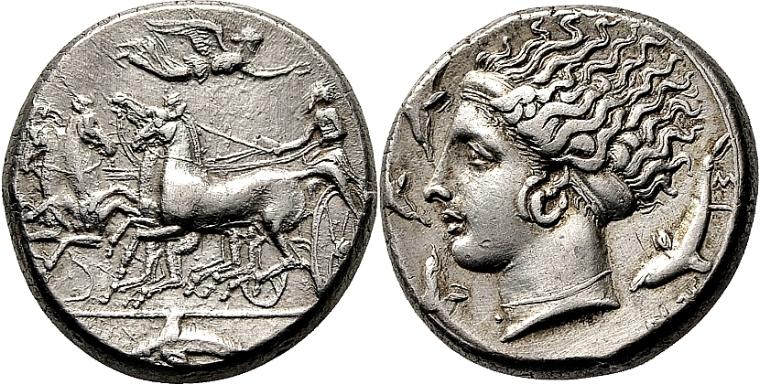Syracuse, silver, tetradrachms (quadriga/Arethusa) (399-387 BCE) (Fischer-Bossert)
From SILVER
399 BCE - 387 BCE Silver 2,630 kg
Description
| ObverseInscription or printing placed on the obverse.: | Fast quadriga driven l. by charioteer, holding kentron and reins, above, Nike flying r. to crown him. In exergue, dolphin to l. |
| ReverseInscription or printing placed on the reverse.: | ΣY – PA – K – O – ΣΙ – Ω – Ν (Greek).Head of Arethusa l., hair bound with sphendone over which several tresses fly back. Around, four dolphins: two swimming l. downwards and two r., upwards |
Mint and issuing power
| MintIdentifies the place of manufacture or issue of a numismatic object.: | Syracuse | Ancient regionAncient region.: | Sicily | Modern countryModern country: Italy | AuthorityIdentifies the issuing power. The authority can be "pretended" when the name or the portrait of X is on the coin but he/she was not the issuing power. It can also be "uncertain" when there is no mention of X on the coin but he/she was the issuing power according to the historical sources: | Dionysius I of Syracuse (tyrant of Syracuse, c. 400-367 BC) |
Chronology
| FromIdentifies the initial date in a range assigned in a numismatic context. | 399 BCE | toIdentifies the final date in a range assigned in a numismatic context.. | 387 BCE | PeriodTime period of the numismatic object.: Classical 480-323 BC |
Physical description
| MetalThe physical material (usually metal) from which an object is made.: | Silver |
Median weightMedian of the weights of numismatic objects (in grams). in grams | 17.30 | DenominationTerm indicating the value of a numismatic object. Examples: tetradrachm, chalkous, denarius.: | tetradrachm |
StandardStandard.: | Attic |
Image

S 1079 - Syracuse, silver, tetradrachm, 399-387 BC.jpg [1]
References
| Die study referencePublication of the study: | Fischer-Bossert 20171Fischer-Bossert 2017, p. 179-191, O33-O39 | ||
| Coin series referenceReference to coin series study: | Tudeer 19132Tudeer 1913 | ||
Obverse dies distribution
| FrequencyFrequency of specimen in distribution. ᵖ | Number of obversesNumber of obverse dies. ᵖ (o) | % (o) | Number of coinsNumber of coins. (n) | % (n) | Die nameName(s) of the die(s). |
| 1 | 1 | 12.5 | 1 | 0.24 | 39 |
| 5 | 1 | 12.5 | 5 | 1.19 | 37 |
| 10 | 1 | 12.5 | 10 | 2.38 | 38 |
| 14 | 1 | 12.5 | 14 | 3.33 | 36 |
| 63 | 1 | 12.5 | 63 | 14.96 | 35 |
| 96 | 1 | 12.5 | 96 | 22.8 | 33 |
| 116 | 2 | 25 | 232 | 55.11 | 34 |
| Total | 8 of 8 | 100 | 421 of 421 | 100.01 |
Reverse dies distribution
no distribution is available
Quantification
| Number of obversesNumber of obverse dies. ᵖ (o) | 8 | Number of singletons (o1)The number of singleton coins. ᵖ | 1 |
| Number of reverse diesNumber of reverse dies. (r) | 17 | Number of coinsNumber of coins. (n) | 421 |
| Coins per obverse dieNumber of coins per obverse die. (n/o) | 52.63 | Coins per reverse dieNumber of coins per reverse die. (n/r) | 24.76 |
| Reverse per obverse ratioRatio of obverse dies divided by reverse dies. (r/o) | 2.13 | Percentage of singletons (o1)number of coins (n) divided by the number of singletons (o1) ᵖ | 12.5 % |
| Original number of dies (O) (Carter 1983 formula)The estimation of the number of coins according to Carter 1983 ᵖ | 7.6 | Coins struck if 20,000 as average productivity per dieCoins made if the average productivity for obverses (according to Carter) is 20,000. ᵖ | 152,000 |
| Original number of dies (O) (Esty 2011 formula)The estimation of the number of coins according to the singleton formula in Esty 2011 ᵖ (O) | 8.15 | Survival rate if 20,000 as average productivity per dieSurvival rate if average productivity is 20,000. ᵖ | 0.00277 |
| Coverage (o = % of O) (Esty 1984 formula)Esty 1984 - coverage (% of O) ᵖ (o = % of O) | 99.76% | Die productivity if survival rate 1/2,000Average productivity if survival rate is 1/2,000. ᵖ | 110,789.47 |
| Weight of silver (in kg) if 20,000 coins per die (O = Carter formula)Carter 1983 * Median weight * 20000 (*10 if gold or electrum) ᵖ | 2,630 kg <br /> 2,630 kg | Die productivity if survival rate 1/5,000Average productivity if survival rate is 1/5,000. ᵖ | 276,973.68 |
Remarks
References
- ^ Fischer-Bossert, Wolfgang (2017), Coins, Artists, and Tyrants. Syracuse in the Time of the Peloponnesian War, Numismatic Studies 33, New York, The American Numismatic Society, 371 p., 27 pl., 30 cm.
- ^ Tudeer, Lauri O. Th. (1913), Die Tetradrachmenprägung von Syrakus in der Periode der Signierenden Künstler, Berlin, 292 p. : ill., VII pl. ; 24 cm.